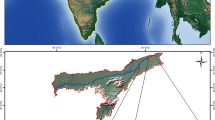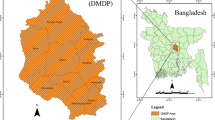Abstract
GIS based land resource inventory (LRI) with fine resolution imagery is considered as most authentic tool for soil resource mapping. Soil resource mapping using the concept of soil series in a smaller scale limits its wide application and also its impact assessment for crop suitability is controversial. In this study, we attempted to develop LRI at large scale (1:10,000 scale) at block level land use planning (LUP) in Dandakaranya and Easternghats physiographic confluence of India. The concept of land management unit was introduced in this endeavour. The impact assessment of LRI based LUP was exercised to develop efficient crop planning with best possible management practices. The study area comprised six landforms with slope gradient ranging from very gentle (1–3%) to steep slopes (15–25%). The very gently sloping young alluvial plains occupied maximum areas (19.95% of TGA). The single cropped (paddy) land appears to dominate the land use systems (40.0% of TGA). Thirty three landscape ecological units were resulted by GIS-overlay. Eighteen soils mapping units were generated. The area was broadly under two soil orders (Inceptisols and Alfisols); three great group (Haplaquepts, Rhodustalfs and Endoaquepts) and ten soil series. Crop suitability based impact assessment of LRI based LUP revealed that average yield of different crops increased by 39.2 and 14.5% in Kharif (rainy season) and Rabi (winter) seasons respectively and annual net returns by 83.4% for the cropping system, compared to traditional practices. Productivity and net returns can be increased several folds if customized recommended practices are adopted by the farmers. Informations generated from the study emphasized the potentiality of LRI towards optimizing LUP and exhibited an ample scope to use the methodology as a tool to assess in other physiographic regions in India and abroad.






Similar content being viewed by others
References
Adhikary, P. P., Madhu, M., Dash, J., Sahoo, D. C., Jakhar, P., Naik, B. S., et al. (2015). Prioritization of traditional tribal field crops based on RWUE in Koraput district of Odisha. Indian Journal of Traditional Knowledge, 2, 88–95.
Annual Report. (2012–13). ICAR-NBSS&LUP, Nagpur.
Annual Report. (2013–14). ICAR-NBSS&LUP, Nagpur.
Bandyopadhyay, S., Reza, S. K., Baruah, U., Sah, K. D., Sarkar, D., Ramachandran, S., et al. (2017). District land use planning Jorhat, Assam, Report No. 1077 (p. 92). Nagpur, Maharashtra: ICAR-NBSS&LUP.
Bandyopadhyay, S., Reza, S. K., Dutta, D. P., Baruah, U., Sah, K. D., & Singh, S. K. (2015). Development of integrated land use plan for Upper Brahmaputra Valley under rain-fed ecosystem: A case study in Jorhat district, Assam. Agropedology, 25(2), 181–194.
Baruah, U., Bandyopadhyay, S., & Reza, S. K. (2014). Land use planning and its strategic measures in the context of North Eastern Regions of India. Agropedology, 24(2), 292–303.
CGWB. (2013). Ground water information booklet, Bolangir District, Orissa (pp. 1–28). Bhubaneswar: Ministry of Water Resources, Central Ground Water Board, SER.
District Contingency Plan. (2012). http://www.crida.in/cp-2012/index.html. Hyderabad, Telengana: ICAR-CRIDA.
Jakhar, P., Barman, D., Naik, B. S., Gowda, H. C. H., Naik, G. B., & Gore, K. P. (2010). Participatory rural appraisal for integrated planning and sustainable watershed development—A case study of Lachhaputtraghati watershed. Indian Journal Soil Conservation, 38(3), 223–228.
Joshi, P. K., Jha, A. K., Wani, S. P., Laxmi, J., & Shiyani, R. L. (2005). Meta analysis to assess impact of watershed program and people’s participation, Research Report 8. Comprehensive Assessment of Watershed Management in Agriculture, International Crops Research Institute for the Semi-Arid Tropics and Asian Development Bank.
Joshi, P. K., Jha, A. K., Wani, S. P., Sreedevi, T. K., & Shaheen, F. A. (2008). Impact of watershed programme and conditions for success. A meta analysis approach. Global Theme on Agro-ecosystems, Report No. 46. ICRISAT.
Kasturirangan, K., Aravamudan, R., Deekshatulu, B. L., Joseph, G., & Chandrasekhar, M. G. (1996). Indian remote sensing satellite IRS IC. The beginning of new era. Current Science, 70, 495–500.
Kudrat, M., & Saha, S. K. (1993). Land productivity assessment and mapping through integration of satellite and terrain slope data. Indian Journal of Remote Sensing, 21, 151–166.
Madhu, M., Naik, B. S., Jakhar, P., Hombe Gowda, H. C., Adhikary, P. P., Gore, K. P., et al. (2016). Comprehensive impact assessment of resource conservation measures in watershed of eastern region of India. Journal of Environmental Biology, 37(3), 391–398.
Manchanda, M., Kudra, M., & Tiwari, A. K. (2002). Soil survey and mapping using remote sensing. Tropical Ecology, 43(1), 61–74.
Nagarajua, M. S. S., Kumar, N., Srivastava, R., & Das, S. N. (2015). Cadastral-level soil mapping in basaltic terrain using Cartosat-1-derived products. International Journal of Remote Sensing, 35(10), 3764–3781. https://doi.org/10.1080/01431161.2014.919675.
Ololade, I. A. (2010). A study on effects of soil physico-chemical properties on cocoa production in Ondo state. Modern Applied Science, 4, 35–43.
Ramamurthy, V., Naidu, L. G. K., Nair, K. M., Ramesh Kumar, S. C., Srinivas, S., Thayalan, S., et al. (2015). District land use planning of Mysore, Karnataka. NBSS Publ. No. 169 (p. 95). Nagpur: ICAR-NBSS&LUP.
Sarkar, D., Sah, K. D., Sahoo, A. K., & Gajbhiye, K. S. (2005). Soil series of Orissa, NBSS Publ. 119. Nagpur: ICAR-NBSS&LUP.
Sarkar, D., Thampi, C. J., Sehgal, J., & Velayutham, M. (1998). Soils of Orissa for optimizing land use, NBSS Publ. 49 b (Executive Summary). Nagpur: ICAR-NBSS&LUP.
Saxena, P. R., & Prasad, N. S. R. (2008). Integrated land and water resources conservation and management—development plan using remote sensing and GIS of Chevella sub-watershed, R.R. district, Andhra Pradesh, India. The International Archives of the Photogrammetry, Remote Sensing and Spatial Information Sciences, 37, 729–732.
Seid, N. M., Yitaferu, B., Kibret, K., & Ziadat, F. (2013). Soil–landscape modeling and remote sensing to provide spatial representation of soil attributes for an Ethiopian watershed. Applied and Environmental Soil Science. https://doi.org/10.1155/2013/798094.
Sehgal, J. (1995). Land resource for sustainable agriculture. In Proceeding INSA symposium on sustainable management of natural resource. New Delhi.
Sharda, V. N., Dogra, P., & Dhyani, B. L. (2012). Indicators for assessing the impacts of watershed development programmes in different regions of India. Indian Journal of Soil Conservation, 40(1), 1–12.
Sharda, V. N., Samra, J. S., & Dogra, P. (2005). Participatory watershed management programmes for sustainable development: Experiences for IWDP. Indian Journal of Soil Conservation, 32(2), 93–103.
Singh, S. K., Chaterjee, S., Chattaraj, S., & Butte, P. S. (2016). Land resource inventory on 1:10000 scale, why and how? (p. 94). NBSS Publ. 172. Nagpur: ICAR-NBSS&LUP.
Soil Survey Staff. (2003). Soil taxonomy, agricultural handbook, Title, 436 (3rd ed.). Washington, DC: NRCS, USDA.
Srivastava, R., & Saxena, R. K. (2004). Techniques of large scale soil mapping in basaltic terrain using satellite remote sensing data. International Journal of Remote Sensing, 25(4), 679–688.
Sys, C., Van Ranst, E., & Debaveye, J. (1991). Land evaluation, Part-II. Methods in land evaluations, Agricultural Publication No. 7. Brussels: FAO.
Sys, C., Van Ranst, E., Debaveye, J., & Beernaert, F. (1993). Land evaluation, part-III. Crop Requirements, Agricultural Publication No. 7. Brussels: FAO.
Van de Wauw, J., Baert, G., Moeyersons, J., Nyssen, J., De Geyndt, K., Taha, N., et al. (2008). Soil–landscape relationships in the basalt-dominated highlands of Tigray, Ethiopia. Catena, 75, 117–127. https://doi.org/10.1016/j.catena.2008.04.006.
Velayutham, M. (2000). Available soil information and the need for the systematic classification of soils of India. Journal of Indian Society of Soil Science, 48, 683–689.
Velayutham, M., Mandal, D. K., Mandal, C., & Sehgal, J. L. (1999). Agro-ecological sub regions of India for planning and development, NBSS Publ. 35. Nagpur: NBSS & LUP (ICAR).
Velmurugan, A., & Carlos, G. G. (2009). Soil resource assessment and mapping using remote sensing and GIS. Journal of Indian Society Remote Sensing, 37, 511–525.
Walia, C. S., Singh, S. P., Dhankar, R. P., Ram, J., Kamble, K. H., & Katiyar, D. K. (2010). Watershed characterization and soil resource mapping for land use planning of Moolbari watershed, Shimla, H.P., in lesser Himalayas. Current Science, 98(2), 176–182.
Acknowledgements
The author’s place on record sincere thanks to all the technical persons involved in field and laboratory data recording and analysis. We also express our gratitude to Dr. S. K. Singh, Director, ICAR-NBSS&LUP, and Nagpur for sincere assistance and encouragement. National Remote Sensing Agency, Hyderabad and Global Land Cover facility, USA is gratefully acknowledged for data products used in the study.
Author information
Authors and Affiliations
Corresponding author
About this article
Cite this article
Ghosh, B.N., Das, K., Bandyopadhyay, S. et al. Impact Assessment of GIS Based Land Resource Inventory Towards Optimizing Agricultural Land Use Plan in Dandakaranya and Easternghats Physiographic Confluence of India. J Indian Soc Remote Sens 46, 641–654 (2018). https://doi.org/10.1007/s12524-017-0743-1
Received:
Accepted:
Published:
Issue Date:
DOI: https://doi.org/10.1007/s12524-017-0743-1




